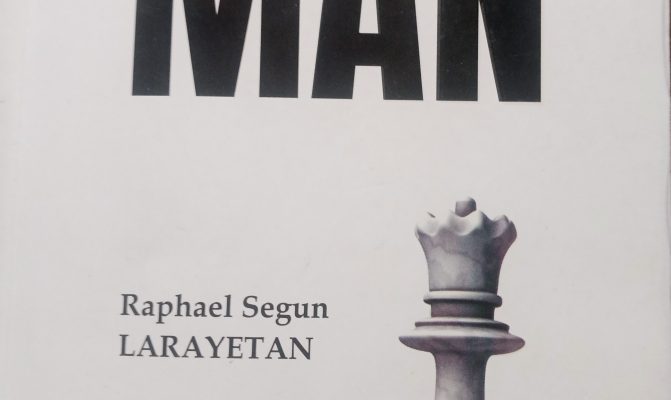In Behind Every Miserable Man, Dr. Raphael Segun Larayetan lays bare the reality that man’s miserableness in life differs from family to family, but of all mysteries, the inability of man to speak-up and man-up when faced with certain realities (especially if no one will believe him) is the mother of all mysteries, but also unthinkable is the discovery by one who thought his marriage was stable that all his children were fathered by different men, which calls for a review of the over emphasis on the empowerment of the girl-child and ‘demasculanization’ of the male gender
By Edu Abade
Besides what Prof. Patrick Oloko of the Department of English, University of Lagos described as ‘the demasculinization of the male gender,’ quite a number of things are at once intriguing about the subject matter and motif of Dr. Raphael Segun Larayetan’s Behind Every Miserable Man.
How can a woman batter a man to the extent of landing him in hospital several times? How can a man’s three children suddenly become strangers to him having been fathered by two other men in a supposedly healthy marriage? How can a lie be so sustained to such an extent that the victim of domestic violence (this time against the husband) ends up taking his life? How can Senator Raymond’s friends-Jide, Kelvin and Julius be so hoodwinked into keeping mum over their friend’s true ordeal? How can a lawyer and Shalewa (blinded by her hatred of the word rape) be so bent on condemning an innocent man and refuse to back off even when the truth was finally revealed? And how can one justify that Sharon would frame up her husband (Jide) for killing her man friend (Lawrence) with whom she has had a child, whereas the real killer is another younger man friend (Caleb) she engaged to satisfy her sexual inanities?

A reading of Larayetan’s very compelling and unputdownable Behind Every Miserable Man has thrown the above questions and even more at humanity’s conscience and the fact that the over emphasis on empowering the girl-child to the detriment of the male counterpart has created multiple layers of challenges. First is that the male gender at whose expense the girl-child is being empowered in the 21st century are becoming subservient and losing confidence in themselves and the marriage institution and to that extent, are shying away from relationships and marrying the super-woman. Second, in the western world, not wanting to be under the control of their male counterparts, women are now becoming more detached from marriages, preferring rather to embrace single motherhood. This phenomenon now permeates the African continent-a situation that if not carefully managed, will spell doom for the God-ordained marriage institution.
Third is that this has created another daunting challenge-that of men refusing to speak up even in life threatening situations in their marriages, prompting concerned persons to canvass a balance in gender empowerment and the right to man-up and speak-up in unpalatable conditions.
Forth, considering the plight of the likes of Jide whose three kids were fathered by Gbade and Lawrence, is the subtle suggestion that families should be encouraged to carry out Deoxyribonucleicacid (DNA) tests at the birth of every child to determine their true paternity with a view to avoiding the pitfalls that might result from the discovery of a different parenthood.
Coming to the nitty-gritty of the novel written in simple, easy to read prose of 10 chapters in 211 pages, Larayetan deftly wove each of the chapters into subtitles of The Seat of Elders; All Three Sides of A Story; The Mountain Of The Dead; The Language Of The Serpent and Cloud Of Chaos. Others are, The Devil Can’t Grow Beards; The Hanging Man; Tales From The Devil; Where Eagles Go To Die and The Morning After The Storm, each with a complete blend of character delineation aimed at further deepening the subject matter and motif. And take it or leave it, were it not fiction, several heads would roll in real life situations at the revelations one encounter in this literary work.
But in all, Behind Every Miserable Man is a striking embodiment of literary realism, demonstrating a profound commitment to the truthful representation of the often-unspoken struggles within marriages and relationships. Anchored in the ethos of realism-a movement intent on rejecting idealization in favour of the gritty details of everyday existence-Larayetan’s novel methodically dismantles the façade of domestic bliss to reveal the silent agonies endured by men and women alike.
At its core, Behind Every Miserable Man gives voice to those who have historically remained silent, particularly men whose vulnerabilities have been culturally suppressed. Through characters such as Jide Williams, Raymond Thomas and Julius, the novel portrays the emotional, psychological, and sometimes physical wounds that men sustain behind closed doors. Jide’s disillusionment-the revelation of betrayal by a wife he believed he had secured through financial provision-underscores the novel’s exploration of misguided societal assumptions: that wealth ensures loyalty or affection.
In similar fashion, Raymond Thomas’s tragic demise in the hands of a violently abusive spouse demonstrates the lethal consequences of societal expectations on men to endure in silence. Julius’ journey further explores the tension between duty and personal fulfillment, as he navigates a marriage increasingly devoid of intimacy and emotional connection.
Parallel to these narratives of masculine despair, the author also examines the plight of the unmarried woman through Shalewa’s story. Here, realism finds its most poignant expression: in a society where a woman’s worth is often measured by her marital status, Shalewa is a successful woman perpetually diminished by cultural scorn. The internal and external conflicts she faces-including suicidal ideation-are rendered with harrowing authenticity, situating her experience within a broader commentary on societal expectations and gendered oppression.
Larayetan’s characterization is deftly executed. The protagonists are neither saints nor sinners, but rather complex, flawed individuals shaped by forces both internal and external. The author’s refusal to offer easy resolutions further enhances the novel’s realist framework. Instead, the work posits painful, enduring questions about duty, justice, perception, and personal happiness-questions that defy simple moral binaries. The figure of Janet O. Lanre, a lawyer torn between legal justice and ethical rectitude, epitomizes this tension. Her professional and personal dilemmas mirror those faced by the other characters, suggesting a pervasive moral ambiguity in human relations.
Stylistically, Larayetan’s prose is sober and unembellished, in keeping with the realist tradition. The narrative structure interweaves multiple storylines without collapsing into melodrama, maintaining a deliberate pace that allows for the slow, often painful, unfolding of the characters’ realities. The thematic integration of betrayal, isolation, societal expectation and moral conflict is executed with careful balance, ensuring that no single issue overwhelms the narrative but instead contributes to a broader tapestry of human suffering and endurance.
Ultimately, Behind Every Miserable Man is a sobering exploration of the invisible burdens borne by individuals in contemporary society. By laying bare the dissonance between societal ideals and personal realities, the writer invites readers to reconsider entrenched notions of success, loyalty, marriage, pain and happiness.
In doing so, the novel not only reinforces the enduring relevance of realism as a literary mode but also positions itself as a crucial commentary on the emotional landscapes too often overlooked in public discourse. Larayetan’s work is both a mirror and a challenge: To see, to understand and perhaps to empathize more deeply with the silent struggles that shape human lives.
A central theme of this remarkable literary work remains that until humanity strikes a balance between societal values and resolve the girl-child, male-child dichotomy, society risks more tragic incidents as experienced by the Raymonds, Jides, Kelvins and Juliuses that would dovetail into violence and crises of unimaginable proportions!
Therefore, a resolution of the subject matter hinges on society’s ability to check the excesses of serpentine women like Elizabeth, Sharon (who had three children with two different men apart from her husband), Shalewa, Ngozi and the overbearing mother-in-law, Mrs. Ugochukwu and the other vicious characters in the novel, who are bent on making even the best of men miserable.




